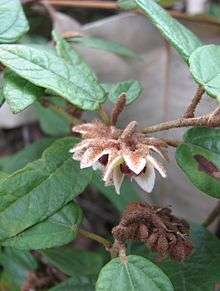Lasiopetalum macrophyllum
Lasiopetalum macrophyllum, commonly known as shrubby velvet bush, is a common shrub of the mallow family found in eastern Australia.[1] Growing up to a metre tall, much of the plant is covered in rusty hairs. It is found in forest, woodland and heathland.
| Shrubby velvet bush | |
|---|---|
 | |
| Scientific classification | |
| Kingdom: | Plantae |
| Clade: | Tracheophytes |
| Clade: | Angiosperms |
| Clade: | Eudicots |
| Clade: | Rosids |
| Order: | Malvales |
| Family: | Malvaceae |
| Genus: | Lasiopetalum |
| Species: | L. macrophyllum |
| Binomial name | |
| Lasiopetalum macrophyllum | |
| Synonyms | |
It was first described by Scottish botanist Robert Graham in 1841.[2] Its species name is derived from the Latin "large-leaved".[3]
Lasiopetalum macrophyllum is an (often untidy) erect to spreading shrub to 2 m (6.6 ft) high and 4 m (13 ft) wide. The new growth is prominently covered with red-brown hair. The leaves are oblong, lanceolate or cordate (heart-shaped) and measure 5–12 cm (2–4.5 in) long by 1–4 cm (0.5–1.5 in) wide.[1] They are either smooth or sparsely covered with fine hairs and have prominent veins on both sides; the veins are raised and rust-coloured on the leaf underside.[3] Flowering occurs August to December. The few-flowered cymes are densely covered with hair, and the calyces are rust-coloured and hairy on the outside and cream and smooth inside.[3] The hairless inside of the flowers distinguishes it from Lasiopetalum ferrugineum.[4]
The range is from central New South Wales into Victoria and Tasmania,[1] as well as islands in Bass Strait.[3] It is found in sclerophyll forest and heathland. It is often a spreading shrub in more exposed areas and taller in sheltered areas and gullies.[3] It grows on sandy soils.[5]
Lasiopetalum macrophyllum was introduced to cultivation in England in 1835. Its flushes of rust-coloured new growth have some ornamental appeal, and it grows fairly readily in part-shade in the garden, and is propagated by seed or cutting. Forms with more attractive new growth and prostrate habit have been selected for the garden. It grows in well-drained soils in sun or part shade and is frost tolerant.[3] It has also been classified as somewhat fire retardant.[6]
References
- "Lasiopetalum macrophyllum". PlantNET - NSW Flora Online. Retrieved 20 August 2010.
- "Lasiopetalum macrophyllum Graham". Australian Plant Name Index (APNI), IBIS database. Centre for Plant Biodiversity Research, Australian Government.
- Elliot, Rodger W.; Jones, David L.; Blake, Trevor (1993). Encyclopaedia of Australian Plants Suitable for Cultivation:Volume 6 - K-M. Port Melbourne: Lothian Press. p. 54. ISBN 0-85091-589-9.
- Fairley, Alan; Moore, Philip (2000). Native Plants of the Sydney District:An Identification Guide (2nd ed.). Kenthurst, NSW: Kangaroo Press. p. 81. ISBN 0-7318-1031-7.
- Lasiopetalum macrophyllum
- Marriott, Neil (4 May 2010). "Australian Native Plants For Fire Protection". Australian Plants Society (SGAP Victoria) website. Australian Plants Society (SGAP Victoria) Inc. Archived from the original on 28 August 2010. Retrieved 22 August 2010.